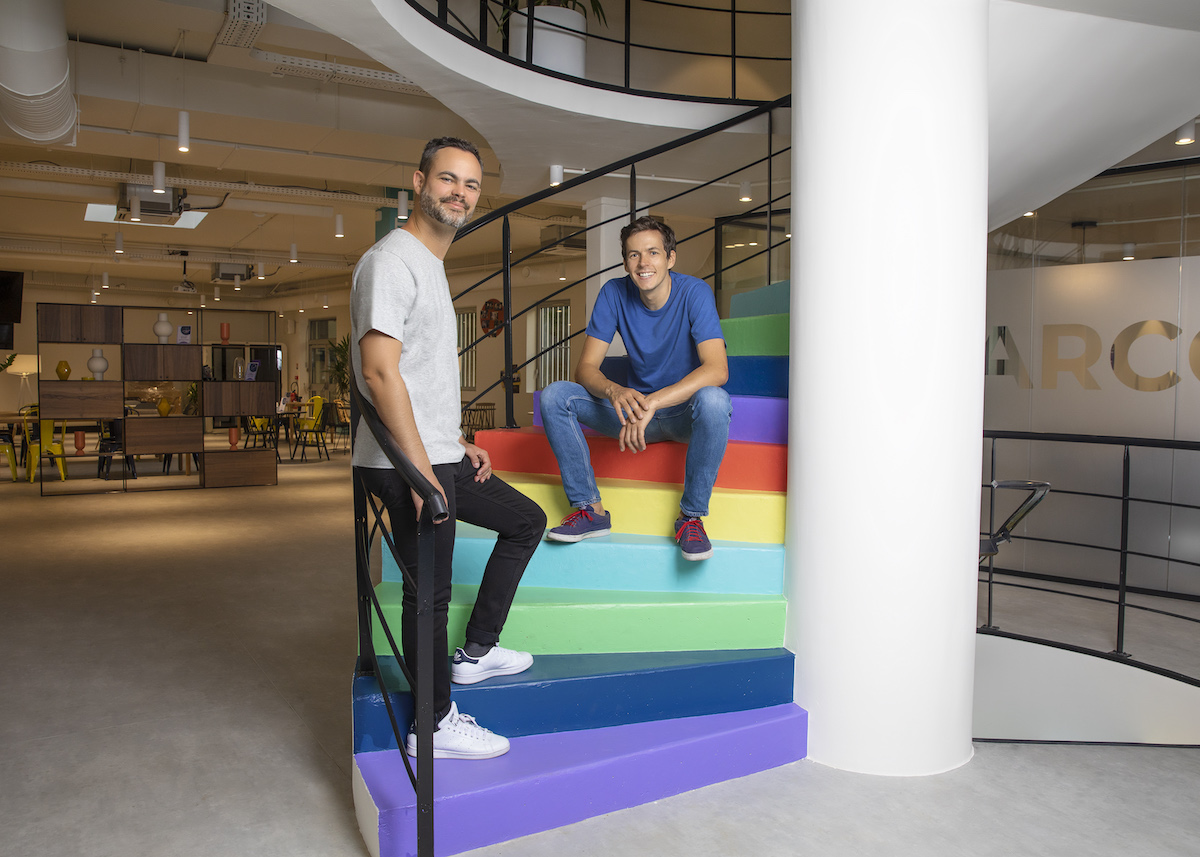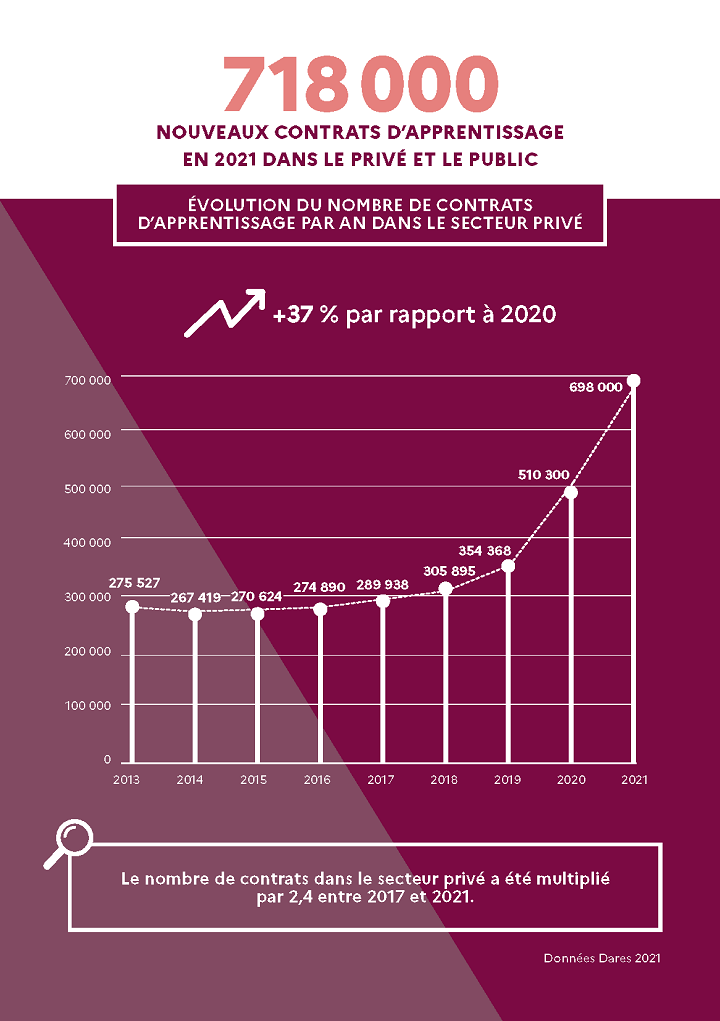
UNIVERSIDAD 2024
openclassrooms
by Pierre Dubuc, Co-founder & CEO
Expanding the talent pool with modern apprenticeships.
Companies lack enough appropriately skilled workers to perform, grow, and beat their competition, and they need an immediate method for addressing this challenge—or else risk losing ground in the marketplace. Workers need training and skills that will increase their employability today and prepare them for the complex, technology-dependent jobs of the future.
Apprenticeships have existed for a long time in several countries in Europe, including Germany, Switzerland, France and the UK. What is new, however, is that apprenticeships are getting more and more recognized as a serious training method. In the past, it was seen as a solution for low-skilled workers, especially in blue collar manual jobs. This is not the case anymore, as many white collar jobs are now being taught in apprenticeships as well: HR, web development, marketing… Even the highly skilled data scientist trainings are now available in apprenticeships format. College degrees, bachelor’s and master’s degrees can also be obtained through apprenticeship.
The apprenticeships exponential growth in France
France has bet big on the growth of the apprenticeship market. While the PIC is a significant but temporary training budget, apprenticeships are recurrent. They are widely seen as a strong lever to create long term employment. In fact, 75% of all apprentices, all sectors combined, have found a job 6 months after their training1.
Overall, in 2022, nearly 829,000 apprenticeship contracts were signed in France, representing a 12.8% year-on-year increase. The volume of these contracts had already surged by 37% between 2020 and 2021, as highlighted by Dares2. As of the end of March 2023, there are slightly over 953,000 apprentices in France, compared to 662,100 two years earlier. Two main reasons can explain this growth:
- A new law from 2018 simplified access to the apprenticeship contract, making it more financially interesting and removing some of the conditions that were blocking access to students.
- A temporary bonus for companies who would hire an apprentice: 5,000€ to 8,000€ for each new apprenticeship hired. This bonus was launched in the middle of the 2020 year and was extended afterwards. It’s now been simplified to 6,000 € per apprentice hired.
All this contributes to making the apprenticeship model more widely known and appreciated, potentially creating a virtuous circle in which more companies are going to hire more apprentices in the future. It’s important to note that many companies, especially the small ones, are still not used to apprenticeships and need to learn how it works (they know about internships, but less about apprenticeships).

Apprenticeships in the United States, a niche market
Outside of France, to understand the breadth of the talent crisis, consider this: at the end of 2022, US companies needed 10.5 million workers to fill job openings in a labour market where 5.7 million people were unemployed3. These shortages are impacting businesses across all sectors, though some—healthcare, technology, and manufacturing—are feeling it more acutely than others.
As more companies in the U.S. embrace the potential of apprenticeships, they’re adopting a practice that has been common in Europe and Asia for decades: partnering with third- party intermediaries to establish and operate their apprenticeship programs. Apprenticeship intermediaries are a vital cog in the process—a key to deciphering governmental red tape, designing successful programs, and ensuring apprentices have the wraparound support to be successful. Ultimately, intermediaries absorb administrative tasks on behalf of the companies for whom they work, while also providing the kind of specialized training and support that employers may have little time for or expertise in. And those services have tremendous value for businesses across all sectors.
Even as employers across industries acknowledge the value of apprenticeship programs, companies have been slow to adopt them. In the U.S., they have remained largely a niche pathway, with just under 600,000 apprentices4 across the country in the last fiscal year, compared to about 16 million undergraduates5 in two-year and four-year colleges. Those apprentices are largely concentrated in trades—carpentry, electrical, and plumbing, in particular—and manufacturing positions.
There’s no single reason for that disconnect, since every sector faces its own set of hiring challenges. There is, however, a common thread uniting companies across industries: it’s hard to know where to start. Until recently, U.S. businesses haven’t had the luxury of partnering with the kind of apprenticeship intermediaries that have flourished in Europe, helping companies with program design.
Burdened by the current employment crisis, business leaders across all industries are examining whether apprenticeship programs can address their needs. In many ways, an apprentice is the ideal employee—someone trained from day one on tasks that are specific to their jobs even as they’re working toward a credential.
And the roles are attractive to would-be employees, as they get to learn and earn wages at the same time. Many apprentices develop such an affinity for their sponsoring company that they not only join as full-time employees but stay longer than other new hires—a practice that cuts down attrition while saving precious training dollars.

The need for a different talent pathway
The truth is that today’s skill and talent shortfall is the result of complex economic and cultural factors forming a perfect storm of employment challenges. And the tight labour market shows no signs of loosening anytime soon, despite headline-making layoffs at some of the worlds’ biggest corporations6.
Yet this crisis is more complicated than simply finding workers to fill open positions. In a world where jobs increasingly require specialized skills, companies face the additional burden of hiring employees with the right skills. For example, employment in tech occupations—especially data science, cybersecurity, and software development— has outpaced overall job growth for years. Hiring in these fields is expected to grow at twice the rate of overall employment in the next decade7.
Additionally, the challenge of workplace diversity and equity continues to impact competitiveness, productivity, and corporate missions. Businesses of all sizes have rolled out major new Diversity, Equity and Inclusion initiatives, with leaders pledging to hire workers who better reflect the communities they serve and in which they operate. But many of those initiatives stalled in 2022, proving that the task is far from complete8.
The bottom line? Companies working in most high-demand fields are struggling to find the talent and skills they need from a pool of appropriately trained workers who reflect America’s diverse population. Modern apprenticeships provide a new tool for changing that equation. For starters, apprenticeship programs widen the pool of available job candidates. This is especially true for apprenticeships in fields like technology, healthcare, and financial services—which were all but unheard-of in the U.S. a decade ago.
A major analysis of these “new” apprenticeships by Opportunity@ Work, a nonprofit advocating for new pathways to good jobs, and Lightcast, a leading labor market analytics firm, found that the apprentices were significantly more diverse than the current workforce in the roles they were training for9.
• 18% of apprentices in new fields were Black and 19% were Latino, compared to only 11% and 16% (respectively) of the workers in the roles the apprentices were training for.
• Apprentices were also more likely to be women than were incumbent workers in their fields. In software engineering, for example, 31% of apprentices were women, compared to only 19% of workers in those jobs.
The report is clear about the implications of those findings: “New apprenticeships create a talent pipeline for their target roles that is more diverse than the current population in those roles.”
For one, businesses no longer must rely on “traditional” education and training pipelines—which have not served all Americans equally well—since every apprentice receives on-the-job training designed specifically for their industry. Apprenticeships also can help combat workplace bias by allowing hiring managers to test out candidates before they commit to a full-time hire. And because apprenticeships take less time to complete than the typical associate or bachelor’s degree, they satisfy employers’ immediate requirements for hiring, training, and deploying talent while also filling the pipeline for future needs.
New alliances encouraging Apprenticeship growth
Aon, a global professional services firm, has been particularly vocal about the role apprenticeships can play in bringing more women, people of colour, and those from less advantaged communities into high- growth professional roles.34 It partnered with Accenture and Zurich insurance in 2017 to create the Chicago Apprentice Network to spread the word to more companies and help them get their own programs off the ground. The network, which serves as a kind of employer-led intermediary, has since expanded to six other cities, and Aon has committed $30 million to growing the network to 10,000 apprentices by 2030.10
And the US federal government is putting muscle behind that kind of work, including last year launching the Apprenticeship Ambassador Initiative, a national network of more than 200 employers and other organisations that have signed on to create hundreds of new registered apprenticeships.11 “These results will increase our skilled workforce—including people in underrepresented communities, especially women, people of colour, veterans, and people with disabilities—equipping them with good- paying, high-quality jobs and a pathway to the middle class,” Marty Walsh, then the U.S. secretary of labour, said at the launch.
Apprenticeship Intermediaries and ROI
There’s strong evidence showing that apprenticeship intermediaries can boost returns for companies that invest in apprenticeship programs. For example, the study by the Commerce Department and Case Western Reserve included a cost-benefit analysis of the
services provided by LaunchCode, a nonprofit tech apprenticeship intermediary.12 The analysis found that the out-of-pocket costs for employers using LaunchCode are about $900 less than when making off-the-street hires.
That return doesn’t even take into account any of the potential long-term benefits that companies may see from reduced turnover or long-term differences in productivity of off-the-street hires and apprentices. And it doesn’t reflect the time and resources that companies save when someone else navigates the registration process, creates courses, and recruits apprentices.
Merck, for example, was able to launch its apprenticeship program within three weeks of finalising the apprenticeship job descriptions because of the strategy and operations support provided by OpenClassrooms. And the applicant pool of 700 exceeded expectations.
OpenClassrooms latest results
OpenClassrooms trained thousands of apprentices, on programs ranging from 12 to 24 months. All their apprenticeship programs in France lead to associate’s, bachelor’s or master’s degrees. In the US, partnerships with community colleges allow apprentices to receive college credits for the duration of their apprenticeship: 30 US credits, the equivalent of a full college year, for 1 year of apprenticeship.
The US remains a less mature market on apprenticeship, with scattered funding schemes both for apprenticeship training costs and wages. OpenClassrooms partners with community colleges, like Bakersfield college in California, to match apprenticeship candidates to local employers around the college, and plug into funding programs to help employers offset most of the cost. A typical program leads to 100 apprentices per community college, in tech and digital jobs. Most employers are local small and medium businesses.
Completion of such apprenticeship is above 90%, while the vast majority is then hired permanently by their employer. In France, the job placement rate on a degree apprenticeship program is 15 points higher than the job placement rate on the same degree, but not in apprenticeship. The efficiency of modern apprenticeship, combined to college degrees, is now proven at scale.
Conclusion
Solving the talent shortage that’s currently confounding businesses, combined with the need for more appropriately trained and skilled workers, will be no small feat. It will require companies, higher education institutions, governments, and other partners to redouble their efforts—as well as their investments.
Apprenticeships are one of the most practical solutions to this dilemma. They not only provide workers with a way to earn money while they’re learning vital skills, but they give employers a low-risk way to diversify their workforces while in many cases seeing a positive ROI.
Apprenticeship intermediaries are a way for companies to accelerate these opportunities, and to do so in a way that’s more efficient and cost-effective. By doing the heavy lifting—registering a program from scratch, building relationships with academic partners, monitoring the progress of a program and individual apprentices—they free business leaders to focus on other critical aspects of their operations. And ultimately, intermediaries demystify the apprenticeship process, giving employers an increased sense of confidence as they venture into the unknown.
Author: Pierre Dubuc
Co-Founder & CEO at OpenClassrooms

Universidad 2024 was created in collaboration with:
The Proeduca Group
PROEDUCA’s objective is to provide the best online higher education to its students and it achieves this through educational commitments at three universities: The International University of La Rioja, the Online University of Mexico (UNIR Mexico), and CUNIMAD. It also offers studies located in Peru, at the Newman Postgraduate School, and in the United States, where it has a presence through MIU City University Miami.
